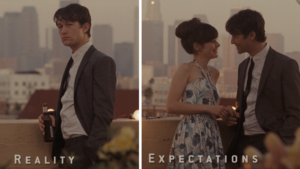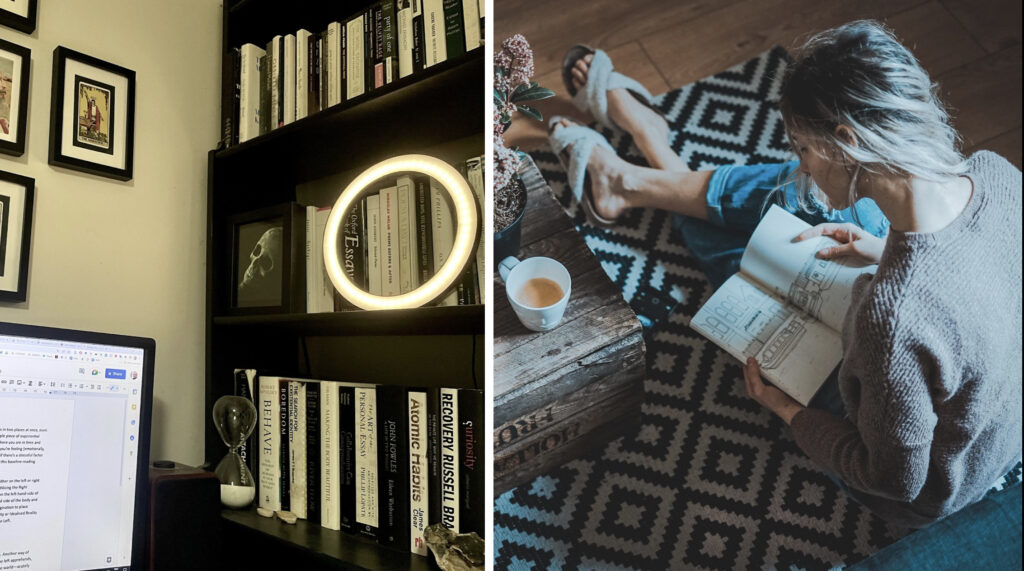 Being split-brain creatures, is it any surprise that our minds are almost always in two places at once, even if we’re not entirely conscious of this set-up. This can be verified by a simple piece of experiential enquiry. Take a reading right now of your inner and outer world: wherever you are in time and space, whatever tasks you’re about to carry out, or have just finished doing. Get a sense of how you’re feeling (emotionally, physically), how in tune you are at this moment with your needs and desires. If there’s a stressful factor present in your consciousness as you read this, add that into the mix. And let’s call this baseline reading REALITY, or at least your reality in this moment.
Being split-brain creatures, is it any surprise that our minds are almost always in two places at once, even if we’re not entirely conscious of this set-up. This can be verified by a simple piece of experiential enquiry. Take a reading right now of your inner and outer world: wherever you are in time and space, whatever tasks you’re about to carry out, or have just finished doing. Get a sense of how you’re feeling (emotionally, physically), how in tune you are at this moment with your needs and desires. If there’s a stressful factor present in your consciousness as you read this, add that into the mix. And let’s call this baseline reading REALITY, or at least your reality in this moment.
Now imagine a screen representing the mind, and place your Reality Snapshot either on the left or right hand side of that screen. Often when we are taking this global reading, we are utilising the Right Hemisphere, so you might feel more comfortable putting your Reality image on the left-hand-side of this imaginary screen. This is because the Right Hemisphere of the brain controls the left side of the body and so receives information from the left visual field. Having done that, now use your imagination to place another image or even a set of moving images on the other side of the screen. So on the left, you now have Reality, and on the right-hand side of your screen, you have a kind of Enhanced-Reality or Idealised Reality.

In my case, Reality (left) is me sitting here on a Tuesday evening writing this small article on my desktop computer, Diwali fireworks going off every two seconds, and my doggo Max perched somewhat nervously under the desk as if the two of us were in a war zone. The reality-enhanced Ideal, imagined on the right-hand side of my screen, features a loving partner (a fantasy image: I don’t have a significant other in my life right now) reading quietly beside me, or in the other room, no fireworks, the two of us just about to check in and decide what we’re having for dinner and/or whether we might watch a film later, or have an early night.
Until I consciously set the Real next to the Ideal, as I have just done, I wasn’t at all aware that this Ideal was so “close to mind” as it turned out to be – it took me literally half a second for my writing mind to come up with its preferred fantasy in juxtaposition to my perfectly adequate but un-preffered living reality.
Of course as soon as we do this, as soon as we become conscious of this experiential gap between the two versions of being (Reality and The Ideal), an additional layer of emotion or thought is soon present and ready to rhumba. In my case: sadness, longing, and feelings of emptiness. These are not unfamiliar emotions to me, especially in the evenings, but often they arrive unbidden and as part of the seemingly baseless emotional weather patterns that I experience throughout the day, when in fact they might be better understood as an inner jarring response to the cognitive dissonance experienced in our nervous systems when the Real and the Ideal fail to coalesce.
Spoiler alert: for most of us, these two realms fail to coalesce about 90% of the time.
But don’t take my word for it. Run the split-screen experiment in different set-ups for yourself in the next few days (when feeling stressed, relaxed, in different modes and social configurations) and see if the left-hand side of the screen, The Real, ever gets anywhere near the right-hand side image or perception of The Ideal.
Try it out the next time you argue with your significant other. Have a 5 minute time-out from the argument and share your split-screen images, noticing no doubt some interesting differences in (1) in your so-called “objective” perceptions of The Real (as in: what are we actually fighting about here?), and (2) giving yourselves the possibility of having a good old laugh, or a good old cry, at how far both of you have failed each other in meeting the emotional, cognitive, and behavioural criteria of your respective Ideal wishes.
Another interesting relational aspect to think about in this enquiry is what flavour or theme often plays a part in our Idealisations.
- If you are a “Heart Type”, which is to say that your personality style is centred on feeling emotions and interacting with others through empathy and relationships, then your focus is most likely to reflect this bias in one or both of your split screens. My Ideal as a Four often has a relational component to it, or rather focuses on what is lacking at a relational level, either within myself, or my circumstances (see above). This can also be projected outwards at another as a form of criticism: “Why are you treating me in this way?”. Or even: Why am I suffering Life (at an emotional level) in this way?!” This is often the case for Twos, Threes, Fours, and the many (if not constant) Idealisations that pour out of our Heart Operating Systems.
- If you are a “Head Type” (Fives, Sixes, and Sevens) some form of thinking and analysing will no doubt be at the forefront of your Idealisations, as well as your particular take on Reality, as you are currently perceiving it. Also perhaps your critique (unconscious or acknowledged) of the person or situation you might be in conflict with, as we attempt to figure things out, strategising, anticipating, often with some anxiety or fear.
- Body types (Eights, Nines, Ones) will lend our own embodied Operating System to whatever Ideal is floating unconsciously through your brains and nervous systems, until we attempt to haul it into consciousness in therapy, or as we have done above. Remember: the body is the centre of sensing things physically, through “gut knowing” and instinctive responses, also housing our “movement” centre, which directs action or inaction. Our Idealisations as a Body Type, but also our critiques of others will probably find some bearing in our primary Operating System, focusing on boundaries, tension or numbness, defending or maybe even dissociating in some way, often with some form of irritation present.
[Read more about your Heart/Body/Instinct Operating System]
I guess, as with all of this stuff, perhaps just knowing that we are rarely seeing the world on one screen, can give us a bit more wherewithal and clarity when we are suffering. Because even when we think we’re seeing the world through our most objective Reality lens, some sort of Personality-Focused overlay is always at work.
Theoretically, but maybe also experientially, this ability to see and acknowledge the gap between that Ideal right-hand side of the screen compared to what’s really happening in the “reality” of our being, might then allow us to (ideally?) hold back from tormenting ourselves or others with fantasies and commentaries stemming from those alternate realities and Idealisations, filled with Idealised Selves, and no bothersome fireworks.
